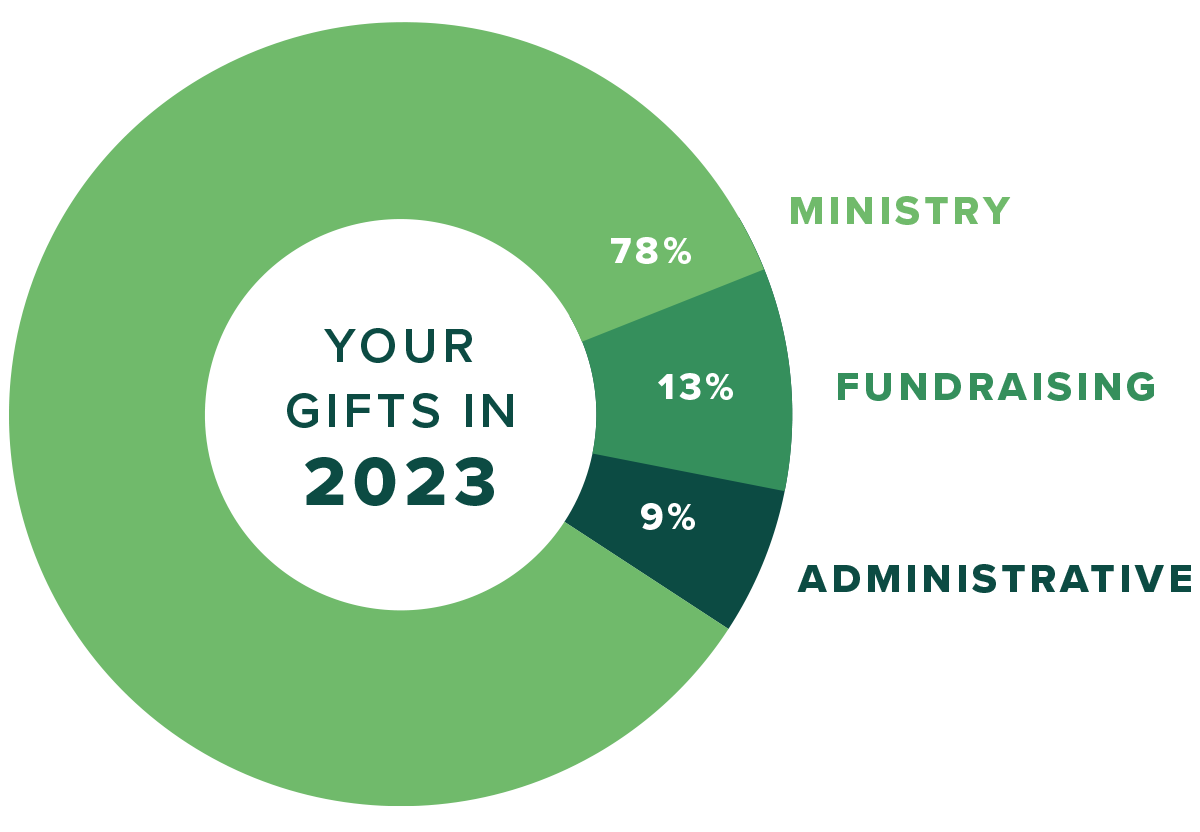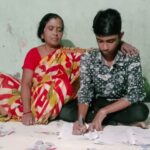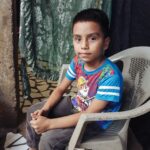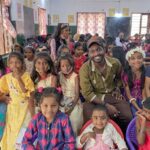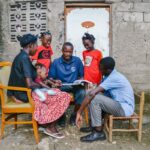After being inspired by his father to pursue his gifts and talents as a boy, a Child Champion is helping children and families overcome the challenges of poverty in Kenya by teaching his shoemaking skills so they can dream beyond their circumstances.
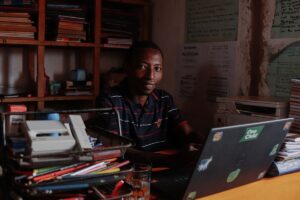
Child Champion Kevin chose to teach his sandal-making skills to youths to help them earn an income.
Because children are at school during the week, the Joy Hope Center in Malindi holds programs on the weekend. Like other Hope Centers in Kenya, weekdays are usually quiet with only the Child Champions there preparing for the weekend.
But on this Thursday it is different.
From the gate, you can see smoke from the kitchen and kids tidying the grounds.
After about 30 minutes, activities outside come to an end as the kids move into different rooms at the center. Some go to a classroom, while others head to the office.
Extra Learning Time
At the office, Child Champions Kevin and Joyce are preparing books and pencils for the kids. Schools are on holiday and the kids are going to write letters to their sponsors before they resume school.
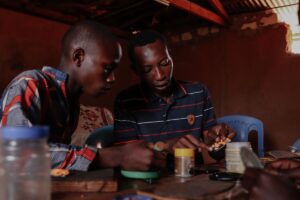
Kevin shows a student the detailed process of beading sandals.
But some of the kids are also there for special training that is changing the economic future for their families.
In the classroom next to the office, a group of boys sit waiting for Kevin, who teaches them a skills class. They gather together some pieces of leather, pairs of scissors, thread, beads, and other materials before Kevin steps in.
When schools are open the class takes place on Saturdays. But with the schools closed, Kevin holds classes three times a week. He teaches the kids how to make sandals using beads and leather.
In 2021 when Kevin joined the Hope Center as the director, he was excited about his role. And he was soon to experience the joy that comes from serving kids in the impoverished community at Langobaya.
A Father’s Love and Guidance
Before joining the Hope Center, Kevin, 29, helped run his parents’ business in Malindi. He also owned a workshop where he made and sold sandals.
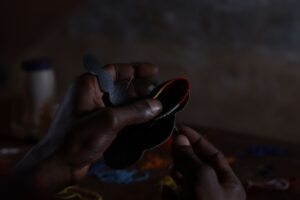
A boy carefully sews beads onto a patch of leather that will become part of the sandal.
His skill in making sandals dates back to his childhood.
As a child, Kevin and his family lived in a church compound where his father ministered as an assistant pastor at a church in Matsangoni, Kilifi County.
When away from the church and not running a shop they owned, his father spent his free time drawing calligraphy. As he drew, little Kevin would watch and admire the drawings.
That went on until Kevin started school and learned how to read and write. In grade three, he realized he had an interest in drawing and picked it up.
“I used to look at pictures in textbooks in school and copy the drawings on my book and then admire the drawing when away from school,” he recalls.
“The first drawings were not so good, but they were the best in my class. When my father found out I had begun drawing, he would help me better the drawings by correcting where I went wrong. He even went ahead and got me a drawing book.”
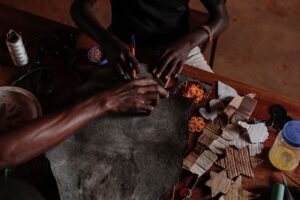
The beading process is intricate.
Kevin’s father also encouraged him to dedicate time and passion to it.
By grade five Kevin had mastered the art. He would imagine drawings and put them on paper without looking at a book for reference.
At school, kids in his class would pay him to help them draw diagrams for their assignments. The money allowed him to treat himself to snacks and toys.
“Back then, most kids thought I was idle and was wasting time; they never thought of art as anything serious,” Kevin says.
“I also never thought much of it, but nonetheless, I did it out of passion. My passion helped me master my craft.”
Mastering a New Art
When he started high school, Kevin thought he wanted to study criminology in college, but his passion for art went a notch higher. For the first time, he got professional coaching on arts and crafts. His school offered lessons, so he joined the class at a time when very few parents encouraged their kids to do art.
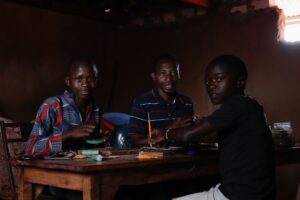
The students are eager to learn a skill that can help them earn income for their families.
“Most parents had a misconception about art. They all wanted their kids to take up serious careers in life, and art was not anywhere close to a serious career,” he recalls. “I was lucky that my father loved and supported me in art. In school, we were thought to be the less serious people.”
From his classes in high school Kevin got a chance to explore and learn about crafts involving textiles, wood, clay, metal, paper, and canvas.
After exploring art involving paper, he went into art involving textiles. His newfound love of art in textiles led him to venture into shoemaking.
After high school, Kevin went to college to study community development, and he joined a team of other artists in a workshop who helped him hone his skills. He made shoes for an income while in college. From his experience in college, he was able to set up his own workshop that kept him busy before he joined the Hope Center.
A Shoemaker Making Shoemakers
At Joy Hope Center, kids learn a variety of skills.
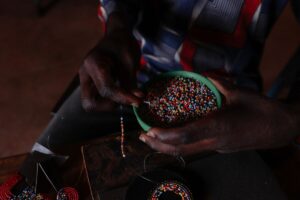
A student sorts through beads to find the right ones for his pattern.
Shoemaking was introduced at the center before Kevin joined, but only a few kids attended the class. But when Kevin joined, more kids registered for the class. He now teaches 17 kids who range between 7 and 12 years old.
Kevin began by changing the kids’ perception about shoemaking. Most of them thought they could never earn a living from it, which Kevin says is a common perception in the community.
“It is sad that to date, people in my community still do not appreciate art. There is a view that arts and crafts are something that people who are considered failures turn to. So, I had to let them know, that despite being their teacher at the Hope Center, I make shoes and earn well from it.”
“My testimony about art won their hearts,” Kevin says. “And that is how our class of 17 kids came to be.”
Learning Step-By-Step
In his class, the kids are divided into different groups and assigned different tasks that contribute to the making of the beaded leather sandals. They are reshuffled through the groups so all of them learn each of the stages of making the shoes.

The final products sell from $5 to $15 each.
According to Kevin, beadwork is the most tasking of all the stages.
“They have to insert a plastic thread into tiny beads then make a pattern out of it,” he explains. “The pattern is made by sewing the beadwork into a leather material that has been cut into a shape depending on the design that one intends to make.”
The beadwork takes time depending on how big a pattern needs to be and the variety of colors that go into it. The more colorful the sandal, the more time they will spend on beading to perfectly match the colors.
After the beading is done, a velvet material is glued onto the opposite side of the beaded pattern to cover the thread that is visible from sewing the beads on the leather. Kevin says the velvet also helps make the sandals smooth and soft on the inside.
They then cut sole leather into different sizes. The Hope Center has a machine that helps them make perfect cuts for the soles. They also have a sewing machine that helps them to sew the patterns on the soles with ease to make a complete sandal.
The Art of Entrepreneurship
After the kids make sandals, Kevin connects them with his clientele and helps them sell their wares. In addition to taking the sandals to Malindi town, 26 miles away, he also posts and sells the products online.
The sandals sell from $5 to $15.
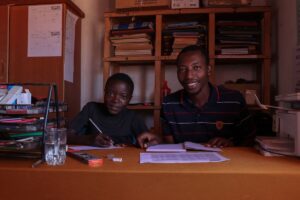
Kevin now teaches 17 youths who range in age from 7 to 12 years.
Kevin says he has taken advantage of the internet to help the kids stay updated with the latest sandal designs and know what clients want.
“I use my phone to research on the market and even learn more skills that I pass on to the kids. We have to embrace technology to be on top of the game,” he says.
“The kids have no phones because their parents can’t afford them, but I use mine and share with them. I’m certain that when they get phones in the future, they will put in practice what we learn in class.”
The Joy of Shaping Futures
Kevin says he always looks forward to days when he has the class with the kids.
“It never feels like I am working, because it’s my passion and talent,” he says. “I also enjoy teaching the kids, because I know that I am living for a purpose, and my purpose on earth is to impact the life of kids in my community. They are learning a skill that can never be taken away from them.”
Besides helping the kids earn money from selling the sandals, Kevin says the training also helps complement the education system in Kenya, where every child is expected to learn a hands-on skill in addition to excelling in their class work.
He also says engaging the kids during holidays has helped keep them away from vices like drug abuse and theft that are currently consuming many teens in the community.
“When the kids are left idle, they find something to do, and mostly it is something bad,” he explains. “Nature has no room for a vacuum, so when they are not engaged, vices find a way of occupying the vacuums in the lives of children. They also have a lot of energy, so I love to have them direct the energy to the right places.”
So as the kids come to the Hope Center to learn shoemaking, Kevin takes that time to talk to them about issues in the community, counsel them, and share the Word of God.
“When the child comes to learn the skill during the holiday, and their friend wants to play, the friend joins them at the center,” Kevin says. “And I take that time to talk to them. And I believe it takes such small effort to address the menace in the community.”
A Blessing to the Entire Community
In addition to teaching the kids, Keving has also taught six of their mothers.
Kevin shared the shoemaking training as a way to teach parents methods of becoming financially empowered. He taught six mothers who came to him how to make the sandals, and now they have a source of income.
The mothers would have had to pay $150 each to learn the skill in a vocational school, but Kevin taught them for free.
He says that previously the mothers did not have a steady income because some depended on hawking fish and vegetables in the community to earn a meager and sporadic income. They struggled to care for their families. But now they make sandals, which they sell to people in the community to earn a living.
Initially people in the community had to spend $8 in transportation to travel to Malindi town to buy a pair of $5 sandals. They now are able to save $8 by buying sandals locally.
“I believe we are able to stand out when we can identify a gap then find solutions to filling the gap,” Kevin says. “This is what I shared with the mothers, and they are now a solution to an existing gap and are also helping eradicate poverty in the community.”
The Ripple Effect
Besides earning an income that helps them secure the future of their kids, the mothers have come to appreciate and encourage their kids to take up art.
Kevin’s hope for the kids is that they can create a ripple effect by sharing their skills and talent and being a blessing to others.
He also hopes that parents and Child Champions can stand in the gap and be change-makers in their communities.
“I give my all while serving these kids, because I believe that through the kids, change can be made in the community,” Kevin says. “I want to live for people and leave the community better than I found it.”
Sponsor a child and join Child Champions like Kevin to create a ripple effect of hope through an entire community.
We are accountable to the children we serve AND to our donors.
Our accountability to our donors is one of our highest priorities. Our goal is to use the funds entrusted to us as wise stewards. To do this requires continued monitoring of our fund distribution. OneChild is also a member in good standing with the Evangelical Council for Financial Accountability (ECFA)
